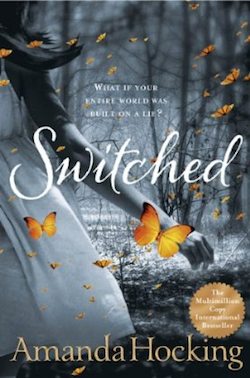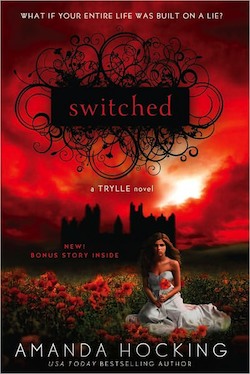Amanda Hocking’s Trylle Series will go on sale on January 3 from St. Martin’s Press, starting with Switched. While you’re waiting to grab a copy for your shelves, settle down with a cup of tea or coffee and enter the world of Trylle, where changelings play a big role. To read a sample chapter, check out the Trylle Series Facebook page. And stick around for two cool book trailers after the cut!
“When Wendy Everly was six years old, her mother was convinced she was a monster and tried to kill her. Eleven years later, Wendy discovers her mother might have been right. She’s not the person she’s always believed herself to be, and her whole life begins to unravel—all because of Finn Holmes.”
A changeling is, simply, a child switched at birth with another child. The practice dates back to pre-Christian times and spans cultures from Western Europe to Egypt. It is most commonly practiced among trolls, elves, fairies, and pixies, and while the specifics of the practice differ, the basics are the same.
Trylle Changelings
Depending on who you talk you, the Trylle are considered the best troll tribe ever. They are known for superior beauty, intelligence, and abilities. Although related to humans, they have some major differences. The first is lifestyle. Unlike most humans, Trylle strive to live a quiet life communing with the earth and each other. While human schools prepare them for a life of “servitude,” Trylle training unleashes their talents. The Trylle devote themselves to strengthening their abilities in order to protect the tribe and guarantee the best life possible. The best way to do this is to have changelings.
The changeling practice dates back hundreds, maybe thousands of years. Originally, the Trylle were forest dwellers, far less industrialized than those in present-day Förening. Trylle children were prone to starvation and medical problems, and raised without an adequate educational system. To fix this, the Trylle began leaving their babies in place of human children, so they could grow up with the benefits only a human childhood could offer—good schools, nutrition, and protection. When they were old enough, the Trylle returned home.
That practice evolved because the Trylle evolved. Changelings were healthier, better educated, and wealthier than the Trylle who stayed behind. Eventually, every child born became a changeling—with the exception of trackers who have no changeling population, ever. Trackers don’t bring money into the community. Instead, they provide a service for other Trylle—(bringing changelings back to Förening)—in return for a home and food.
Of course, nowadays the Trylle could easily match the benefits of the human population, but why bother? In order to sustain the current level of existence in Förening, the Trylle would have to leave the solace of the compound and spend their lives doing menial jobs. That simply would not do.
Instead, the Trylle select the most sophisticated, wealthiest human families to raise their children. Changelings have the best childhoods this world has to offer, and then return home with an inheritance from their host families that infuses Trylle society with wealth and supports the changeling for life.
Trackers usually bring changelings back after they’ve turned eighteen and their abilities have already started to emerge. This gives changelings enough time to figure out that they’re not like everyone else and to want to escape. It’s also in keeping with a lot of human legends that claim changelings only “live” until they are eighteen or nineteen.
The human children, known as Mänkslig, are raised in Förening where they are given everything they need to keep them happy. They aren’t exactly treated as equals and, of course, don’t date or marry Trylle. But when they turn eighteen, they are free to leave—or stay for as long as they like. Trylle don’t tell the mänkslig where they come from so they aren’t tempted to track down their human families. That would be tricky for Trylle society.
 So how does this relate to other tales of changelings?
So how does this relate to other tales of changelings?
Throughout history, humans have latched on to changeling stories in an attempt to explain a difficulties—a baby that is sick or cries all the time, eats too much or too little, or is not attractive.
Human changeling legends are also a way of dealing with the fear and uncertainty around raising a creature as vulnerable as a human newborn. People believed if they turned their backs for even a second, their child would die or be swapped. Legends often cite a beggar woman who admires the child just before the mother notices a shift in its behavior or appearance. Constant vigilance, lights, an article of the father’s clothing, sharp instruments, spices, and even the Bible have all been used to ward off baby-swappers. As if any of those things could match the Trylle power of persuasion!
Whether practiced among trolls, fairies, elves, pixies, or even dwarves, changeling myths have a lot in common.
The number one reason to employ changelings is survival.
As with the early Trylle, sometimes a community simply doesn’t have the resources to raise a child or to hide and protect it from a vicious enemy. In the case of the pixies of Western Europe, protective host families are rewarded with great fortunes. In some parts of Germany, dwarves exchange one of their king’s children with a human child from time to time so that beauty won’t die out among them. For some fairy communities, human breast milk is crucial to the survival of their young.
“You’re not a parasite. They loved you, and you genuinely loved them in return. It is unusual, but that’s not a bad thing. In fact, it’s a very good thing. Maybe it’s given you a compassion that Trylle leaders have been lacking for a very long time.” —Finn to Wendy
A changeling child is at best a stand-out and at worst cranky and difficult around others.
This is, unfortunately, generally true, and particularly among troll tribes in both Scandinavia and Minnesota. Changelings from the Omte tribe (a sister tribe to the Trylle) are infamously unattractive, rude, and cranky. And to be fair, it makes sense that a troll among humans might be happiest when left alone. Trylle children like Wendy, for example, often have strong personalities and may unknowingly wreak a little havoc once their abilities start coming in.
“You were a strong-willed child. You wanted things the way you wanted them. And when you were a baby, you were colicky. But you were always an adorable child, and you were bright and funny.” —Aunt Maggie to Wendy
Most changelings don’t know they’re changelings.
Though they may always feel somewhat different or removed from human life, most changelings are too young to understand who they truly are. This is, of course, for their own protection and happiness. Let’s face it, humans can be mean to anyone they perceive as different. Changelings have to develop strong characters to deal with mistreatment, ridicule, and even abuse.
While some human methods for figuring out if a baby is a changeling are innocuous—like startling it into revealing itself—most methods are cruel and potentially deadly. Humans have been known to set a child over a fire, beat it with a switch, throw it into a river, leave it exposed to the elements overnight, or generally mistreat it. If a changeling doesn’t know it is a changeling, it can’t be abused into revealing its true nature.
“Everywhere I went, kids never seemed to like me. Even before I said or did anything. I felt like I had something wrong with me and everyone knew it. I tried getting along with the other kids, but I’d only take getting pushed for so long before I pushed back. Principals and deans were quick to expel me, probably sensing the same things the kids did.” —Wendy
Changelings eat their human families out of house and home.
This may be the case among fairies and elves—and frankly the notion is too widespread for there not to be a hint of truth in it—but it is unheard of among the Trylle. Trylle changelings are actually rather particular, refusing most processed foods and preferring fruits, vegetables, and nuts. The Vittra have more voracious appetites, but they hardly ever practice changelings.
“There are so many things I wouldn’t eat and I was constantly hungry. It had always been a struggle just to feed me. When I was a baby, I wouldn’t even drink breast milk. Which only added more fuel to the idea that I wasn’t my mother’s child.” —Wendy
Someone is always watching the changeling.
Few magical creatures leave a changeling unguarded. There is almost always some kind of watcher or tracker nearby to snatch the child away if threatened or abused. Trylle trackers, in particular, are often young in order to establish a basis of trust with their charges. In most legends, from Germany, to Ireland to Moravia, an “old woman” appears to snatch a changeling away if it’s threatened. Older changelings, such as fairies in Scotland or “underground people” in Denmark, will often flee an unpleasant situation (though not up the chimney as many humans would have one believe.)
“ There is a place where you belong. There is a place where you have family.” —Finn to Wendy
Amanda Hocking is the author of the Trylle series, the My Blood Approves series, The Hollows series, and the Watersong series. You can find her online at her blog.










